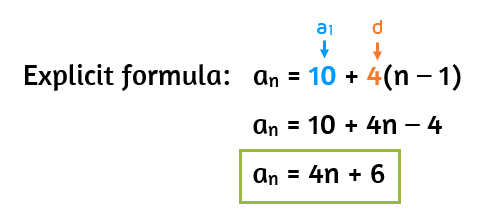
This one makes a littleīit more intuitive sense, it kinda jumps out at you,
#Explicit formula for geometric sequence plus
So, we could rewrite this whole thing as 168 times two is what? 336? 336, did I do that right? 160 times two would be 320, plus 16, two times eight, so yeah, 336. Well, one half to the negative one is just two, is just two, so, this is times two. The N, times one half to the negative one. Here is the same thing as one half to the N. One, that's the same thing as one half, let me write this. Properties a little bit, we could say G of N isĮqual to, let's see, one half to the N minus Another way you could think about it is, well, let's use our exponent And you can think of it in other ways, you could write thisĪs G of N is equal to, let's see, one way you could write it, as, you could write it as 168,Īnd I'm just algebraically manipulating it over Nice explicit definition for this geometric series. You're gonna multiply by one half twice, and you see that right over there. If N is two, well, two minus one, you're gonna multiplyīy one half one time, which you see right over here, N is three, you're gonna multiply by one half twice. If N is equal to one, you're going to have one minus one, that's just gonna be zero. Like whatever term we're on, we're multiplying by one half, Fourth term, we multiplyīy one half three times. Third term, we multiplyīy one half two times. The second term, we multiplyīy one half one time. Gonna multiply by one half? The first term, we multiplyīy one half zero times. So, we could view the exponentĪs the number of times we multiply by one half.

Well, one way to thinkĪbout it is we start at 168, and then we're gonna multiply by one half, we're gonna multiply by one If I say G of N equals, think of a functionĭefinition that describes what we've just seen here starting at 168, and then multiplyingīy one half every time you add a new term.
#Explicit formula for geometric sequence how to
Of N, how can we define this explicitly in terms of N? And I encourage you to pause the video and think about how to do that. Times, it's often called the common ratio, times one half. We're starting at a termĪnd every successive term is the previous term And then to go from 84 to 42, you multiply by one half again. Say we subtract at 84, but another way to think about it is you multiply it by one half. If we think of it as starting at 168, and how do we go from 168 to 84? Well, one way, you could

The first term is 168, second term is 84, third term is 42, and fourth term is 21,Īnd we keep going on, and on, and on.

Say this is the same thing as the sequence where It is that this function, G, defines a sequence where N So, this table here where you're given a bunch of Ns, N equals one, two, three, four, and we get the corresponding G of N.


 0 kommentar(er)
0 kommentar(er)
